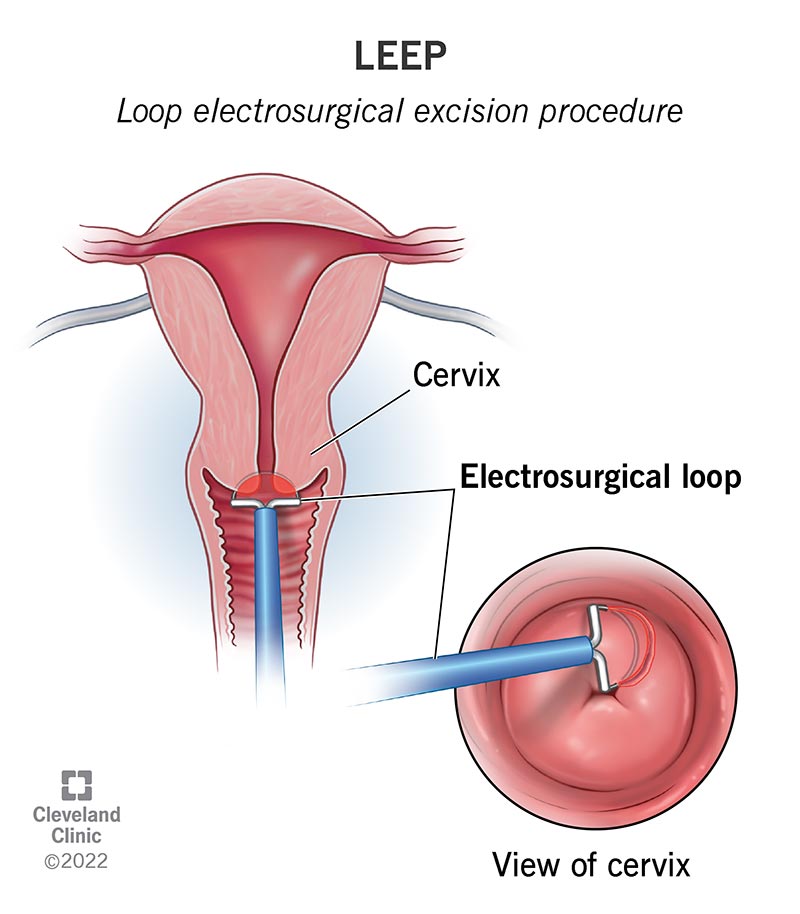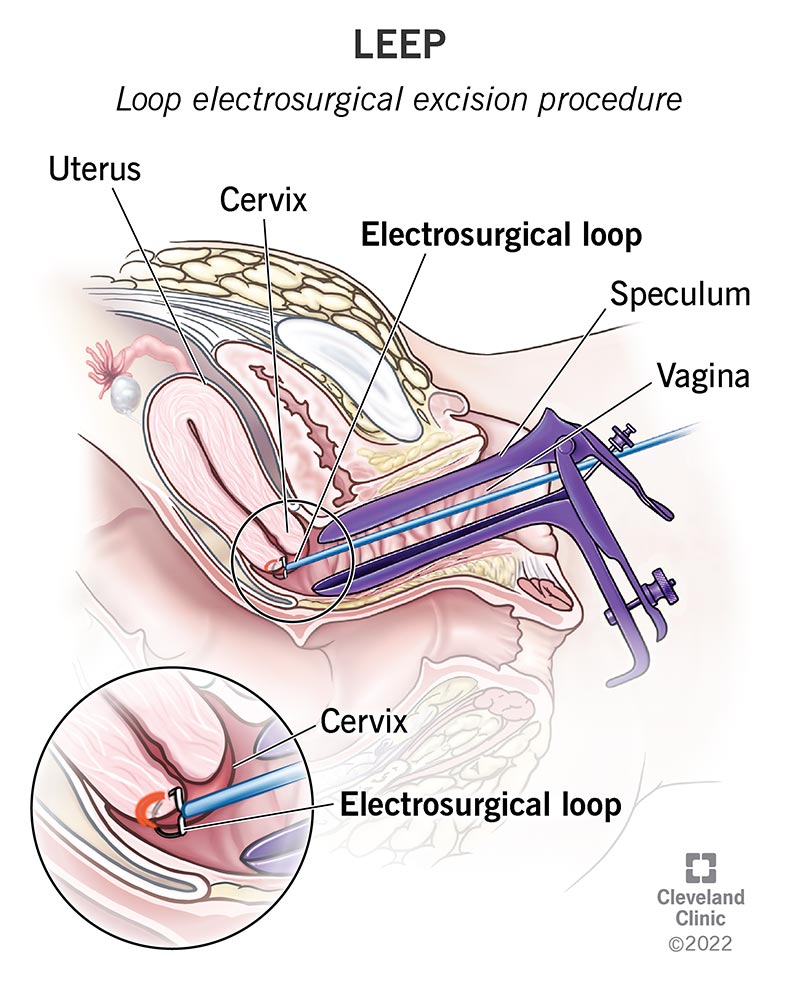A LEEP (loop electrosurgical excision procedure) allows your provider to remove abnormal tissue on the surface of your cervix and, if necessary, test it for cancer. Your provider may prescribe LEEP if a Pap test and colposcopy find abnormal cell growths. The procedure takes about 20 minutes, and the full recovery time is about four weeks.

LEEP (loop electrosurgical excision procedure) tests and treats abnormal cell growth on the surface tissue of your cervix. Your cervix is the opening between your vagina and your uterus. With LEEP, electricity heats an insulated wire loop that's used to remove the abnormal tissue. Once it’s removed, the tissue can be tested for precancerous cells, a condition called cervical dysplasia (cervical intraepithelial neoplasia). Cervical dysplasia isn’t cancer, but it can lead to cervical cancer over time when left untreated.
A LEEP can lead to early diagnosis and prevent cervical cancer.
Advertisement
Cleveland Clinic is a non-profit academic medical center. Advertising on our site helps support our mission. We do not endorse non-Cleveland Clinic products or services. Policy
Your healthcare provider may recommend LEEP after a Pap smear or a colposcopy biopsy confirms that you have abnormal cells in your cervix. Colposcopy is a noninvasive procedure where a device similar to a microscope magnifies your cervix to make abnormal growth easier to see.
LEEP is used to diagnose and treat cervical dysplasia and conditions like genital warts and polyps.

Your healthcare provider will ensure you don’t have any conditions that may prevent you from getting the procedure. For instance, you shouldn’t have a LEEP if you have acute pelvic inflammatory disease (PID) or inflammation of your cervix (cervicitis). You may need to take a pregnancy test before getting a LEEP. Your provider can advise you on the right timing for a LEEP if you’re pregnant.
If there aren’t any contraindications, your provider will schedule the procedure at a time when you’re not menstruating, ideally one week after your period ends.
Follow your provider’s instructions about how to prepare. Your provider may advise you to:
Advertisement
A LEEP can occur in your gynecologist’s office or in a hospital or outpatient setting.
LEEP begins much like a regular pelvic exam. Though you’ll remain awake throughout the procedure, you should feel only minor discomfort. First, your provider will ask you to lie back and rest your feet in stirrups at the end of the exam table. A grounding pad will be placed on your thigh to protect you from the electricity used during the LEEP. Your provider will widen your vagina with a speculum to get a clearer view of your cervix.
A very dilute solution of acetic acid or Lugol’s solution (Iodine) will be added to your cervix to make the abnormal cells visible. Your provider will then place a colposcope near the opening of your vagina. The colposcope will remain outside of your vagina, providing a magnified view of your cervix.
Your provider will use local anesthesia (lidocaine) to numb your cervix. During the injection, you may notice tingling in your tongue, ringing in your ears or a rapid heart rate. If this occurs, it lasts for only a few minutes. Once your cervix is numb, your provider will insert an electrically charged loop made of thin wire through the speculum until it reaches your cervix.
You must remain perfectly still during the tissue removal process. As the loop passes across your cervix, it cuts away a thin layer of surface tissue, removing abnormal cells. Sometimes, your provider will use a second loop to reach a little higher in your cervix. This tissue will be tested later for cancer or abnormal cells.
Finally, your provider will apply a medicated paste (an iron solution called Monsel’s paste) to the area to stop and prevent bleeding.
The procedure takes 10 to 20 minutes. You’ll be able to go home afterward as soon as you feel up to it.
Advertisement
You may feel a small pinch or a sensation like a bee sting when your provider injects the lidocaine into your cervix. Or, you may not feel any sensation at all. You may feel internal pressure or slight discomfort when the cells are being removed. Still, you shouldn’t feel pain because your cervix will be numb from the anesthesia.
Although the sensations feel more like pressure than pain, some people report feeling lightheaded during the procedure. Let your provider know if you start to feel faint at any point during the LEEP.
Afterward, you may feel lightheaded and need to rest in your provider’s office until you’re comfortable enough to drive home. For many people, this rest period takes less than 30 minutes. You’ll receive aftercare instructions to aid in your recovery.
LEEP is very safe. Complications are rare, and the procedure can take place without general anesthesia. As with any surgery, you may be at risk of infection or bleeding. Also, if a large area needs to be removed, or if you need multiple LEEP procedures, your provider will check your cervix by ultrasound during future pregnancies. LEEP may weaken your cervix, leading to early delivery of a baby (preterm birth).
Discuss any concerns you may have, including potential long-term side effects, with your provider.
A LEEP is a safe and effective way to prevent cervical cancer. The success rate for LEEP is excellent, with a 90% cure rate. A LEEP's success depends on various actors, including how advanced your cervical dysplasia is and how much tissue must be removed. In those instances where abnormal cells grow back, your provider may recommend an additional LEEP or other treatments.
You’ll likely feel tired after the procedure. It’s important to get plenty of rest the day of your LEEP. Follow your provider’s instructions on how to care for yourself in the days and weeks ahead.
During recovery, you can expect:
During your recovery, you may experience vaginal bleeding and mild cramping. Take a non-aspirin, over-the-counter pain reliever such as ibuprofen (Motrin®, Advil®) or acetaminophen (Tylenol®) to relieve abdominal cramping.
It takes four to six weeks for your cervix to heal fully following LEEP.
You can return to work or school one to two days after your procedure.
LEEP is both a diagnostic tool and a form of treatment. Removing the tissue for testing often cures cervical dysplasia by eliminating the abnormal cells.
In some instances, you may need a repeat procedure to remove all the cells completely. You may also need an additional LEEP if abnormal cells return. You’re at a greater risk of recurrence if you’re infected with a high-risk strain of the human papillomavirus, or HPV. HPV is responsible for the cell changes associated with cervical dysplasia that can lead to cervical cancer without treatment.
If your HPV persists, you may need frequent Pap and HPV tests to monitor your infection and ensure cervical dysplasia doesn’t progress to cervical cancer.
A hysterectomy is a major surgery to remove your uterus that should never be the first-line treatment for treating abnormal cell growths. Your provider may recommend a hysterectomy if you have more advanced cervical dysplasia, and additional LEEPs or related procedures haven’t prevented abnormal cells from recurring. Talk to your provider about your options based on your unique circumstances.
Contact your healthcare provider if you notice signs of an infection or any of the following symptoms during recovery:
Your provider can use several methods to remove abnormal tissue from your cervix. Some, like LEEP, allow for a pathologist to study a tissue sample for signs of cancer or precancerous cells. These methods include:
The best treatment for you will depend on factors such as the amount and location of the abnormal tissue.
No. But a LEEP can get rid of the abnormal cells that form in response to an HPV infection so that they never become cervical cancer. Depending on your situation, your provider may recommend more frequent Pap smears or HPV tests to ensure no new abnormal cell changes become cervical cancer.
Yes. But unlike the kind of surgery that involves sharp instruments, LEEP uses electricity to cut and remove tissue.
Yes. During the four- to six-week recovery time, new healthy tissue grows on your cervix to replace the removed abnormal tissue.
A note from Cleveland Clinic
It’s normal to feel nervous or even scared at the thought of having a LEEP. Remember that your cervix will be numb throughout the procedure, so the most pain you’ll feel will likely be the anesthesia injection. For many people, the peace of mind that a LEEP offers is well worth the ten to twenty minutes on the exam table. A LEEP can confirm that abnormal Pap results are unrelated to cancer. If cell changes are cancerous, a LEEP can aid in both diagnosis and treatment by removing the abnormal tissue.
Last reviewed on 03/18/2022.
Learn more about the Health Library and our editorial process.
Advertisement
Cleveland Clinic is a non-profit academic medical center. Advertising on our site helps support our mission. We do not endorse non-Cleveland Clinic products or services. Policy